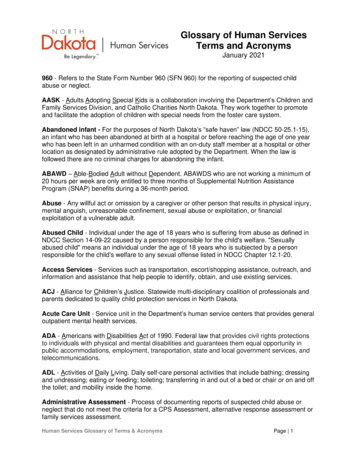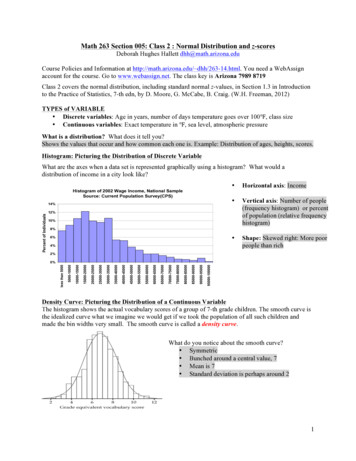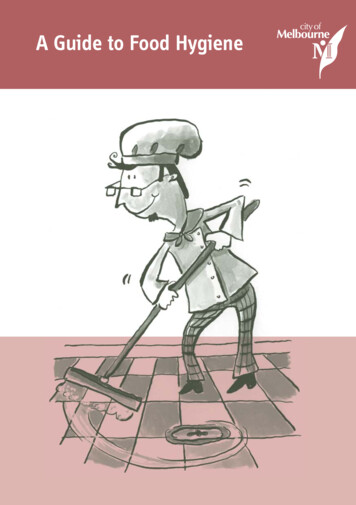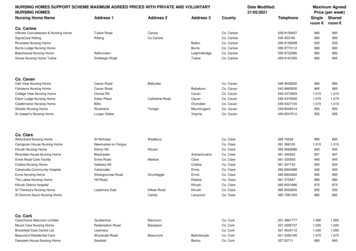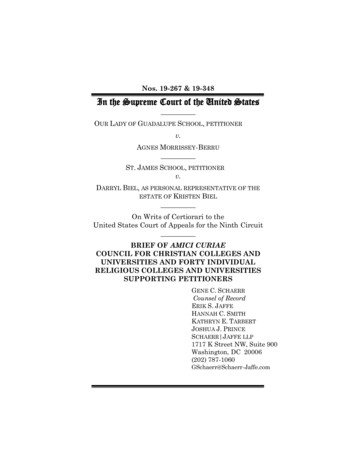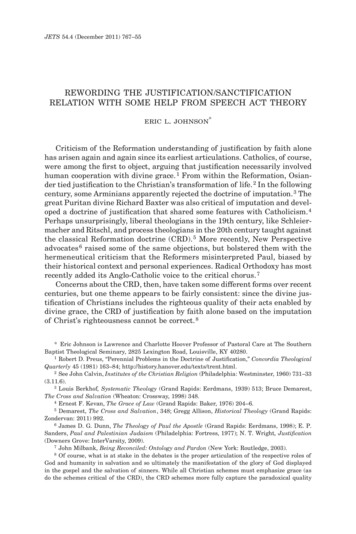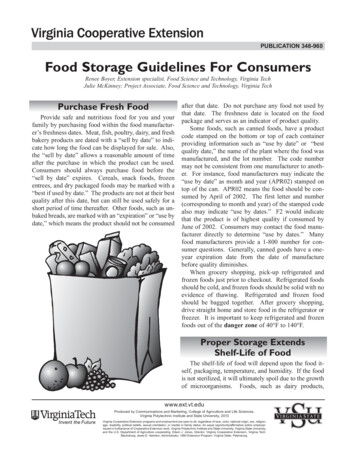
Transcription
PUBLICATION 348-960Food Storage Guidelines For ConsumersRenee Boyer, Extension specialist, Food Science and Technology, Virginia TechJulie McKinney; Project Associate, Food Science and Technology, Virginia TechPurchase Fresh FoodProvide safe and nutritious food for you and yourfamily by purchasing food within the food manufacturer’s freshness dates. Meat, fish, poultry, dairy, and freshbakery products are dated with a “sell by date” to indicate how long the food can be displayed for sale. Also,the “sell by date” allows a reasonable amount of timeafter the purchase in which the product can be used.Consumers should always purchase food before the“sell by date” expires. Cereals, snack foods, frozenentrees, and dry packaged foods may be marked with a“best if used by date.” The products are not at their bestquality after this date, but can still be used safely for ashort period of time thereafter. Other foods, such as unbaked breads, are marked with an “expiration” or “use bydate,” which means the product should not be consumedafter that date. Do not purchase any food not used bythat date. The freshness date is located on the foodpackage and serves as an indicator of product quality.Some foods, such as canned foods, have a productcode stamped on the bottom or top of each containerproviding information such as “use by date” or “bestquality date,” the name of the plant where the food wasmanufactured, and the lot number. The code numbermay not be consistent from one manufacturer to another. For instance, food manufacturers may indicate the“use by date” as month and year (APR02) stamped ontop of the can. APR02 means the food should be consumed by April of 2002. The first letter and number(corresponding to month and year) of the stamped codealso may indicate “use by dates.” F2 would indicatethat the product is of highest quality if consumed byJune of 2002. Consumers may contact the food manufacturer directly to determine “use by dates.” Manyfood manufacturers provide a 1-800 number for consumer questions. Generally, canned goods have a oneyear expiration date from the date of manufacturebefore quality diminishes.When grocery shopping, pick-up refrigerated andfrozen foods just prior to checkout. Refrigerated foodsshould be cold, and frozen foods should be solid with noevidence of thawing. Refrigerated and frozen foodshould be bagged together. After grocery shopping,drive straight home and store food in the refrigerator orfreezer. It is important to keep refrigerated and frozenfoods out of the danger zone of 40 F to 140 F.Proper Storage ExtendsShelf-Life of FoodThe shelf-life of food will depend upon the food itself, packaging, temperature, and humidity. If the foodis not sterilized, it will ultimately spoil due to the growthof microorganisms. Foods, such as dairy products,www.ext.vt.eduProduced by Communications and Marketing, College of Agriculture and Life Sciences,Virginia Polytechnic Institute and State University, 2013Virginia Cooperative Extension programs and employment are open to all, regardless of race, color, national origin, sex, religion,age, disability, political beliefs, sexual orientation, or marital or family status. An equal opportunity/affirmative action employer.Issued in furtherance of Cooperative Extension work, Virginia Polytechnic Institute and State University, Virginia State University,and the U.S. Department of Agriculture cooperating. Edwin J. Jones, Director, Virginia Cooperative Extension, Virginia Tech,Blacksburg; Jewel E. Hairston, Administrator, 1890 Extension Program, Virginia State, Petersburg.
meats, poultry, eggs, and fresh fruits and vegetables, willspoil rapidly if not stored at proper temperatures. Foroptimal quality and safety, dairy products should bestored at refrigerated temperatures between 34 F and38 F, meats between 33 F and 36 F, and eggs 33 F to37 F. Fresh vegetables and ripe fresh fruits should bestored between 35 F and 40 F. Always store refrigerated foods at temperatures less than 40 F. Place a thermometer in the refrigerator and monitor the temperatureoften. This is especially important during the hot summer months.Frozen foods should be stored below 0 F in moisture-proof, gas-impermeable plastic or freezer wrap.Make sure to label and date frozen foods. Frozen foodsmay be safe to eat if stored beyond the recommendedstorage time but quality may diminish. Sometimes consumers will overload a freezer and block the circulationof coolant throughout the freezer compartment. Thiswill lower the efficiency of the freezer in keeping thefood below 0 F.Food that is temperature abused will spoil rapidly asevidenced by off-odors, off-flavors, off-color, and/orsoft texture. For instance, spoiled milk exhibits a fruityoff-odor, acid taste, and may curdle, whereas spoilage offresh fruits and vegetables may exhibit an off-color andsoft texture. Slime on the surface of meat, poultry, andfish indicates spoilage. As microorganisms grow, theyutilize the food as a nutrient source and may produceacids. There is an increased risk of foodborne illnessfrom consumption of spoiled food. Food may be spoiledwithout a detectable off-odor. Discard all foods thatmay have been at room temperature more than 2hours. Therefore, when in doubt throw it out!To ensure food stored in the refrigerator, freezer, orpantry is consumed within the expiration dates, practiceFIFO (First-In-First-Out). When stocking food storage areas, place recently purchased items behind theexisting food items. This will help ensure that you areconsuming food prior to expiration date/spoilage andwill save you money by reducing the amount of food todiscard. Portion leftovers in clean, sanitized, shallowcontainers, and cover, label, and date. Generally, leftoversshould be discarded after 48 hours in the refrigerator.Dry food staples such as flour, crackers, cake mixes,seasonings, and canned goods should be stored in theiroriginal packages or tightly closed airtight containersbelow 85 F (optimum 50 F to 70 F). Humidity levelsgreater than 60% may cause dry foods to draw moisture,resulting in caked and staled products. Canned goodsstored in high humidity areas may ultimately rust, resulting in leaky cans. Discard canned goods that areswollen, badly dented, rusted, and/or leaking.For safety, always store food separate from nonfood items such as paper products, household cleaners, and insecticides. Contamination of food or eatingutensils with a household cleaner or insecticide couldresult in a chemical poisoning.What To Do When ThePower Goes OutWhen the power goes out in the home, minimizeopening the refrigerator and freezer. Refrigerators andfreezers are insulated, aiding in keeping foods cold.However, if the refrigerator or freezer door is openedoften, the cooling will be lost. Perishable refrigeratedfoods (i.e. foods of animal origin) should be discardedafter a 6-hour period. Using block ice may increaseshelf-life of refrigerated foods. Food stored in fullyloaded freezers may last for approximately two days,whereas food stored in partially loaded freezers maylast for only one day. Freezer foods may be refrozen ifice crystals are present. Exceptions include ice cream,pizza, and casseroles. If the frozen food has completelythawed but is cold, it must be cooked within a 24-hourperiod; or foods may be refrozen within 24 hours afterthawing. However, quality may be diminished. If indoubt about when the food actually thawed in thefreezer, discard the thawed food. Dry ice may be usedto keep frozen foods frozen and cold foods cold. Becareful not to handle dry ice with bare hands or breathethe vapors.2
Recommended StorageFor Various Foodsshould be stored in a cool, well-ventilated place between 50 F and 60 F. Tomatoes continue to ripen afterharvesting and should be stored at room temperature.Removing the tops of carrots, radishes, and beets priorto refrigerator storage will reduce loss of moisture andextend shelf-life. Palatability of corn diminishes duringcold storage due to elevated starch content. Corn andpeas should be stored in a ventilated container. Lettuceshould be rinsed under cold running water, drained,packaged in plastic bags, and refrigerated. Proper storage of fresh vegetables will maintain quality and nutritive value.Breads, Cereals, Flour and RiceBread should be stored in the original package atroom temperature and used within 5 to 7 days. However, bread stored in the refrigerator will have a longershelf-life due to delayed mold growth and may befirmer. Expect a 2- to 3-month shelf-life of bread storedin the freezer. Refrigerate cream style bakery goodscontaining eggs, cream cheese, whipped cream and/orcustards no longer than 3 days.Cereals may be stored at room temperature in tightlyclosed containers to keep out moisture and insects.Whole wheat flour may be stored in the refrigerator orfreezer to retard rancidity of the natural oils.Store raw white rice in tightly closed containers atroom temperature and use within one year. Brown andwild rice stored at room temperature will have a shortershelf-life (6 months) due to the oil becoming rancid.Shelf-life of raw white and brown rice may be extendedby refrigeration. Cooked rice may be stored in the refrigerator for 6 to 7 days or in the freezer for 6 months.Processed VegetablesCanned vegetables can be stored in a cool, dry areabelow 85 F (optimum 50 F to 70 F) for up to one year.After one year, canned vegetables may still be consumed. However, overall quality and nutritional valuemay have diminished. Discard badly dented, swollen,and/or rusty cans.Frozen vegetables may be stored in the freezer for 8months at 0 F. Dehydrated vegetables should be storedin a cool, dry place and used within 6 months since theyhave a tendency to lose flavor and color. Home preparedvegetables should be blanched prior to freezing. Formore information on home food preservation see VCEPublication 348-576, Freezing Fruits & Vegetables(http://pubs.ext.vt.edu/348-596/).Fresh VegetablesRemoving air (oxygen) from the package, storingthe vegetables at 40 F refrigerated temperatures, andmaintaining optimum humidity (95 to 100%) may extend shelf-life of fresh vegetables. Most fresh vegetables may be stored up to 5 days in the refrigerator.Always wrap or cover fresh leafy vegetables in moisture-proof bags to retain product moisture and preventwilting. Root vegetables (potatoes, sweet potatoes, onions, etc.) and squashes, eggplant, and rutabagasFresh FruitIn general, store fresh fruit in the refrigerator or in acold area to extend shelf-life. Reduce loss of moisturefrom fresh fruit by using, covered containers. Alwaysstore fresh fruit in a separate storage area in the refrigerator, since fresh fruits may contaminate or absorbodors from other foods. Prior to consumption, rinsefresh fruits and vegetables under cold running waterto remove possible pesticide residues, soil, and/orbacteria. Peeling, followed by washing of fresh fruitsand vegetables, is also very efficient in removing residues.Ripe eating apples should be stored separately fromother foods in the refrigerator and eaten within onemonth. Apples stored at room temperature will softenrapidly within a few days. Remember to remove applesthat are bruised or decayed prior to storage in the refrigerator. Do not wash apples prior to storage.Green pears and apricots should be ripened at roomtemperature and then stored in the refrigerator. Expecta 5-day refrigerated shelf-life for these fruits.Unripe peaches may be ripened at room temperatureand eaten after 2 days. Store ripe peaches in the refrigerator but consume at room temperature.3
the date of manufacture and storage conditions in thegrocers’ shelf. Milk is a very nutritious and highly perishable food. Milk should never be left at room temperature and always capped or closed during refrigeratorstorage. Freezing milk is not recommended, since thethawed milk easily separates and is susceptible to development of off-flavors.Dry milk may be stored at cool temperatures (50 Fto 60 F) in airtight containers for one year. Openedcontainers of dry milk, especially whole milk products,should be stored at cold temperatures to reduce off-flavors. Handle reconstituted milk like fluid milk andstore at refrigeration temperatures if not immediatelyused.Canned evaporated milk and sweetened condensedmilk may be stored at room temperature for 12 to 23months. Refrigerate opened canned milk and consumewithin 8 to 20 days.Natural and processed cheese should be kept tightlypackaged in moisture-resistant wrappers and storedbelow 40 F. Surface mold growth on hard naturalcheese may be removed with a clean knife and discarded. Rewrap cheese to prevent moisture loss. Presence of mold growth in processed cheese, semi-softcheese, and cottage cheese is an indicator of spoilageand thus these foods should be discarded.Store commercial ice cream at temperatures below0 F. Expected shelf-life of commercial ice cream is approximately 2 months before quality diminishes. Immediately return opened ice cream to the freezer toGrapes and plums should be stored in the refrigerator and eaten fresh within 5 days of purchase. Storeunwashed grapes separately from other foods in the refrigerator and wash prior to consumption.Ripe strawberries can be stored in the refrigeratorseparately from other foods for approximately 3 days.Strawberries should be washed and stemmed prior toconsumption.Citrus fruits, such as lemons, limes, and ripened oranges, can be stored in the refrigerator for 2 weeks.Grapefruit may be stored at a slightly higher temperature of 50 F.Melons, such as the honeydew melon, cantaloupe,and watermelon, may be ripened at room temperaturefor 2, 3, and 7 days, respectively. Store ripe melons inthe refrigerator.Avocados and bananas should be ripened at roomtemperature for 3 to 5 days. Never store unripe bananasin the refrigerator, since cold temperatures will causethe bananas to rapidly darken.Processed FruitCanned fruit and fruit juices may be stored in a cool,dry place below 85 F (optimum 50 F to 70 F) for oneyear. As with canned vegetables, badly dented, bulging,rusty, or leaky cans should be discarded. Dried fruitshave a long shelf-life because moisture has been removed from the product. Unopened dried fruits may bestored for 6 months at room temperature.Dairy ProductsThe shelf-life of fluid milk stored in the refrigerator( 40 F) will range from 8 to 20 days depending upon4
prevent loss of moisture and development of ice crystals. Store ice cream at constant freezer temperaturesto slow growth of ice crystals.meats and gas-flushed meats is 14 days and 7 to 12days, respectively.Poultry should be prepared within 24 hours of purchase or stored in the freezer. Poultry may be stored inthe freezer (0 F) for 12 months. Thaw poultry in therefrigerator, under cold running water, or in the microwave. Cook poultry parts (i.e. breast and roast)and whole poultry to an internal temperature of170 F, and 180 F, respectively. Leftovers stored in therefrigerator should be consumed within 3 days and reheated to 165 F prior to consumption. Poultry brothand gravy should not be stored more than 2 days in therefrigerator and reheated to a full boil (212 F) beforeconsuming.Fresh fish, shrimp, and crab stored in the refrigerator(slightly above 32 F) should be consumed within 1 to 2days. Never store fresh fish in water due to leaching ofnutrients, flavor, and pigments. Frozen fresh lean fishand seafood (except shrimp) may be stored for 3 to 6months at 0 F. Shrimp may be stored for 12 months at0 F.Eggs should be purchased refrigerated and stored inthe refrigerator (33 F to 37 F) in their original carton.Storage of eggs in the original carton reduces absorption of odors and flavors from other foods stored in therefrigerator. Use eggs within 3 to 5 weeks of the “packdate” listed on the carton (1 to 365 representing packdate day within the year). Leftover egg yolks and eggwhites may be stored in the refrigerator covered for 2and 4 days, respectively. Cover egg yolks with water.Hard-boiled eggs may be stored in the refrigerator for 1week, whereas pasteurized liquid eggs may be stored inthe refrigerator for 10 days. Egg whites and pasteurizedeggs may be stored at freezer temperatures for one year.Shell eggs should never be stored in the freezer. Driedeggs may be stored in tightly closed containers in therefrigerator for one year.Meats, Poultry, Fish, and EggsMeat, poultry, fish, and eggs are highly perishableand potentially hazardous due to their high moisture andhigh protein content. Generally, fresh cuts of meat contain spoilage bacteria on the surface that will grow,produce slime, and cause spoilage after 3 days of refrigerator storage in oxygen-permeable packaging film.Ground meat products are more susceptible to spoilagedue to the manufacturing process and increased surfacearea of the product. Bacteria in ground meats are distributed throughout, providing rapid growth in the presence of air. Ground meats should be stored on the lowershelf of the refrigerator and used within 24 hours ofpurchase. Refrigerator storage slows bacterial growth;however, the product will eventually spoil. Optimumstorage temperature of refrigerated meats, includingground beef, is 33 F to 36 F.Freezing inhibits the growth of bacteria. Whole cutsof meat may be stored in the freezer ranging from 4 to12 months, whereas ground meat may be stored for 3 to4 months. For maximum storage, wrap meats in moisture-proof, gas impermeable packaging to preventfreezer burn.Cured meats, such as bacon, should be stored in theiroriginal packaging in the refrigerator. Cured meatshave a tendency to become rancid when exposed to air.Therefore, rewrap cured meats after opening the package. Expect approximately a 1-week shelf-life forcured meats. Vacuum-packaging (absence of air) andmodified atmospheric packaging (partial removal ofair) extends shelf-life of meats and meat products (i.e.luncheon meats). The shelf-life of vacuum-packagedWaterCommercial bottled water has an extended shelf-lifeof one to two years due to extensive water treatment(filtration, demineralization, and ozonation) and strictenvironmental controls during manufacturing and packaging. Bottled water should be stored in a cool, dryplace in the absence of sunlight. Household tap waterhas a limited shelf-life of only a few days due to thegrowth of microorganisms during storage. Therefore,consumers should purchase bottled water if planning tostore water for extended periods. The Food and DrugAdministration (FDA) regulates commercial bottledwater as a food. For more information on bottled watersee VCE publication 356-486, Buying Bottled Water(http://pubs.ext.vt.edu/356-486/).5
Recommended Food Storage ChartThe following charts provide general recommended storage times from date of purchase for various food products stored under optimum conditions. Storage generally is not recommended under conditions where no time islisted in the chart. For maximum shelf-life, consumers should always purchase fresh food and never temperatureabuse food. If a product has a "use-by" date, follow that date. If a product has a "sell-by" date or no date, cook orfreeze the product within the times indicated on this chart.FoodBread and Cereal ProductsBaked quick breadsBreadBread crumbs and croutonsBread rolls, unbakedCereals, ready-to-eatCereals, ready-to-cookCorn mealDoughnutsFlour, all-purpose, whiteFlour, whole wheatPastaPies and pastriesPies and pastries, bakedPies and pastries, cream filledPizzaRice, brownRice, whiteTacos, enchiladas, and burritos (frozen)WafflesPackaged Foods and MixesBiscuit, brownie, and muffin mixesCakes, preparedCake mixesCasserole mixChili powderCookies, packagedCrackers, pretzelsFrosting, cannedFrosting, mixFruit cakeHot roll mixInstant breakfast productsPancake and piecrust mixPancake waffle batterToaster pastriesSauce and gravy mixesSoup mixes* Opened CookedPantry(Room Temperature)Refrigerator(33oF to 40oF)Freezer(32oF)4-5 days5-7 days6 months1-2 weeks1-2 weeks2-3 months2-3 months2-3 weeks1 month18 months2 years3 months1-2 years1-2 years1 year2-3 months*6 months1 year4-5 days6-8 months1 year6-8 months2 years3 days6 months1 year2-3 days3-4 days4-6 months1-2 months3 months1-2 months6-7 days 2 weeks4-5 days6 months 1 year1 month9 months2-4 days6-9 months9-12 months6 months2 months3 months3 months8 months2-3 months8-12 months2-3 months1 year1-2 days3 months18 months6 months6 months3 months6 months1 year Refrigerate after opening6# After manufacture date
PantryFood(Room Temperature)Spices, Herbs, Condiments, ExtractsCatsup, chili, and cocktail sauce1 year1 month*6 monthsHerbsHerb/spice blends2 years1 year *2 years6 months1-2 years2 years1 year*1 yearMustardSpices, groundSpices, wholeVanilla extractOther extractsOther Food StaplesBacon bitsBaking powderBaking sodaBouillon productsCarbonated soft drinks (12 oz. cans)Carbonated soft drinks, diet (12 oz. cans)Chocolate, premeltedChocolate syrupChocolate, semisweetChocolate, unsweetenedCocoa mixesCoconut, shreddedCoffee cansCoffee, instantCoffee, vacuum-packedCoffee lighteners (dry)CornstarchGelatinHoney, jams, jellies, and syrupMarshmallowsMarshmallow creamMayonnaiseMolassesNuts, shelledNuts, unshelledNuts, salted* Opened4 months18 months2 years1 year6-9 months3-4 months1 year2 years2 years18 months8 months1 year6 months*2 years2 weeks*6 months2 weeks*1 year 9 months6 months*18 months18 months1 year2-3 months3-4 months2-3 months2 years4 months6 months CookedRefrigerator(33oF to 40oF)6 months1-2 years1-2 years6-8 months*78-12 months1-2 years2-3 years6 months*8 months1 year2 months6 months1 year2 years6-8 months*12 months2 months*6 months# After manufacture date Refrigerate after openingFreezer(32oF)6-8 months
FoodOther Food Staples (continued)Nuts, unsaltedOil, saladPantry(Room Temperature)Pasteurized process cheese spreadPeanut butterPopcornPectinSalad dressings, bottledSoft drinksArtificial sweetenerSugar, brownSugar, confectionersSugar, granulatedTea bagsTea, instantVegetable oilsVegetable shorteningVinegarWater, bottledWhipped topping (dry)Yeast, dry3 months 2 months*10 months2 months*3 months6-9 months2-3 months*1-2 years1 year1 year 3 months2 years4 months18 months2 years18 months2 years6 months1-3 months*3 months2 years1 year*1-2 years1 yearPkg. exp. dateVegetables* OpenedFreezer(32oF)9-12 monthsParmesan grated cheeseAsparagusBeetsBroccoliBrussels sproutsCabbageCarrotsCauliflowerCeleryCorn (husks)CucumbersEggplantGreen beansGreen peasLettuceLima beansMushroomsOnionsRefrigerator(33oF to 40oF) Cooked1 week Refrigerate after opening83-4 weeks*4-6 months4 months2 years2-3 years3 months*6-9 months2-3 days2 weeks3-5 days3-5 days1 week2 weeks1 week1 week1-2 days1 week1 week1-2 days3-5 days1 week3-5 days2 days3-5 days# After manufacture date8 months8 months8 months8 months8 months
FoodVegetables (continued)Onion rings (precooked, frozen)PeppersPickles, cannedFrozen potatoesSweet potatoesWhite potatoesPotato chipsRadishesRhubarbRutabagasSnap beansSpinachSquash, SummerSquash, WinterTomatoesTurnipsCommercial baby food, jarsCanned vegetablesCanned vegetables, pickledDried vegetablesFrozen vegetablesVegetable ed fruitCanned fruit juicesCherriesCitrus fruitDried fruitFrozen fruitFruit juice concentrateFruit pies, bakedFruit, pre-cut, ums* Opened CookedPantry(Room Temperature)Refrigerator(33oF to 40oF)Freezer(32oF)1 year#1 year1 week1 month*8 month2-3 weeks2-3 months1 month2 weeks3-5 days1 week1 week5-7 days3-5 days8 months1 week1-2 years 1 year 1 year 6 months1 week2 weeks2-3 days3-5 days*1-2 months*3-4 daysUntil ripeUntil ripeUntil ripeUntil ripeUntil ripe1 year1 yearUntil ripeUntil ripe6 monthsUntil ripeUntil ripeUntil ripeUntil ripeUntil ripeUntil ripeUntil ripeUntil ripe Refrigerate after opening91 month5 days5 days5 days (fully ripe)3 days2-4 days*3-5 days*3 days2 weeks2-4 days 6 days2-3 days2-4 days5 days5 days5 days5 days5 days5-7 days5 days# After manufacture date8 months3 months1 year1 year1 year8 months1 year1 year1 year1 year
Pantry(Room Temperature)FoodDairy ProductsButterButtermilkCottage cheeseCream cheeseCream-light, heavy, half- and-halfEggnog commercialMargarineCondensed, evaporated and dry milkMilkIce cream and sherbetHard natural cheese (e.g. cheddar, swiss)12-23 months Meats, Fish, Poultry, and EggsMeatsFresh beef and bison steaksFresh beef and bison roastsFresh pork chopsFresh lamb chopsFresh vealFresh ground meat (e.g. beef, bison, veal, lamb)Cooked meatCanned meat1 yearHam, wholeHam, canned2 yearsHam, canned “keep refrigerated”Shelf-stable unopened canned meat(e.g. chili, deviled ham, corn beef)Ham, cook before eatingHam, fully cooked1 yearHam, dry-curedHam salad, store prepared or homemadeBacon1 yearCorned beef, uncooked* OpenedFreezer(32oF)1-2 months2 weeks1 week2 weeks3-4 days3-5 days4-5 months8-20 days*8-20 days9 months3-6 months3-4 weeks*3-4 weeks1 week1-2 days*1 week*2 weeks3 months3-4 weeks2 weeksProcessed cheeseSoft cheese (e.g. brie)PuddingSnack dipsSour creamNon-dairy whipped cream, cannedReal whipped cream, cannedYogurt CookedRefrigerator(33oF to 40oF)3-5 days3-5 days3-5 days3-5 days1-2 days1-2 days2-3 days3-4 days*1 week1 week*6-9 months3-5 days*1week*1 week2 weeks1 week*1 month3-5 days2 weeks1 week*5-7 days# After manufacture date Refrigerate after opening103 months1-4 months6 months12 months3 months2 months6 months6-8 months6 months1-2 months6-9 months9-12 months4-6 months6-8 months4-6 months3-4 months2-3 months3-4 months1-2 months3-4 months3-4 months1 month1-2 months
FoodMeats (continued)Pantry(Room Temperature)Restructured (flaked) meat productsSausage, freshSmoked breakfast sausage links, pattiesSausage, smoked (e.g. Mettwurst)Sausage, semi-dry (e.g. Summer sausage)Sausage, dry smoked(e.g. Pepperoni, jerky, dry Salami)Frankfurters, bologna1 yearFreezer(32oF)1-2 days1 week1 week2-3 weeks*1 month*9-12 months1-2 months2 months1-2 months6 months6 months2 weeks3-7 days*2 weeks3-7 days*1-2 daysLuncheon meatMeat graviesTV beef and pork dinnersMeat based casserolesVariety meats (giblets, tongue,liver, heart, etc.)Vinegar pickled meats(e.g. pickled pigs feet)Refrigerator(33oF to 40oF)3-4 days1 year 1-2 days2 weeks*FishBreaded fishCanned fishCooked fish or seafoodLean fish (e.g. cod, flounder, haddock)Fatty fish (e.g. bluefish, salmon, mackeral)Dry pickled fishSmoked fishSeafood-clams, crab, lobster in shellSeafood-oysters and scallopsSeafood-shrimpSeafood-shucked clamsTuna salad, store prepared or homemade* Opened Cooked1-2 months2-3 months18 months#4 months3-4 months4-6 months1 yearPoultryChicken nuggets or pattiesChicken liversChicken and poultry TV dinnersCanned poultry Cooked poultryFresh poultryFrozen poultry partsCanned poultryPoultry pies, stews, and graviesPoultry salads, store prepared or homemadePoultry stuffing, cooked1-2 months1-2 days*3-4 days1-2 days1-2 days3-4 weeks2 weeks2 days4-5 days4-5 days4-5 days3-5 days1-2 days1-2 days2-5 years3-4 days*2-3 days1-2 days1-2 days1 day1-2 days3-5 days3-4 days# After manufacture date Refrigerate after opening113 months6-10 months2-3 months4-5 weeks3 months3-4 months3 months3 months3 months6 months4-6 weeks4-6 months1 year6-9 months3 months6 months1 month
Pantry(Room Temperature)FoodEggsEggs, in shellEggs, hard-boiledEggs, pasteurized, liquid3-5 weeks1 week10 days3 days*10 days3 days*2-4 days2-4 daysEgg substituteEgg yolks (covered in water)Egg whites(For each cup of egg yolk add1 Tbs. of sugar or salt)Wild GameFrog legsGame birdsSmall game (rabbit, squirrel, etc.)Venison ground meatVenison steaks and roasts* Opened CookedRefrigerator(33oF to 40oF)1 day2 days2 days1-2 days3-5 days# After manufacture date Refrigerate after openingFreezer(32oF)1 year1 year1 year1 year6-9 months9 months9-12 months2-3 months9-12 monthsReferencesAmerican Meat Institute Foundation. 1994. Yellow pages: answers to predictable questions consumers askabout meat and poultry. American Meat Institute Foundation, Washington, D.C.Food Marketing Institute. 1999. The food keeper. Food Marketing Institute, Washington, D.C.Freeland-Graves, J.H. and G.C. Peckham. 1996. Foundations of food preparation, 6th ed. Prentice-Hall, Inc.Englewood Cliffs, NJ.Hillers, V.N. 1993. Storing foods at home. Washington State University Cooperative Extension,Pullman, WA. Publ. EB 1205.National Restaurant Association. 2001. Be cool-chill out! Refrigerate promptly. National Restaurant Association Education Foundation’s International Food Safety Council, Washington, D.C.USDA. 1997. Basics for handling food safely. U.S. Department of Agriculture, Food Safety andInspection Service, Washington, D.C.Originally written by:Tim Roberts, Assistant Professor and Extension Specialist, Food Safety,Department of Human Nutrition, Foods and Exercise, Virginia TechPaul Graham, Associate Professor and Extension Specialist, Muscle Foods,Department of Food Science and Technology, Virginia Tech12
Store raw white rice in tightly closed containers at room temperature and use within one year. Brown and wild rice stored at room temperature will have a shorter shelf-life (6 months) due to the oil becoming rancid. Shelf-life of raw white and brown rice may be extend
